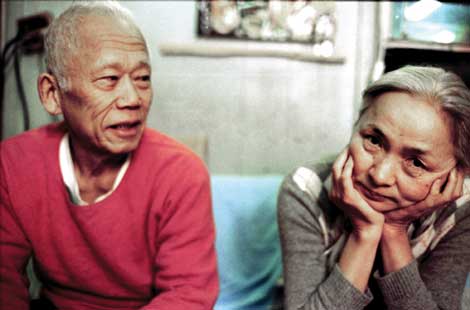Most stories about larger-than-life male artists and their girlfriends/wives share a familiar arc—he overshadows her. When Jackson Pollock and Lee Krasner bought a house in East Hampton, Pollock got to work in the barn, Krasner painted in the bedroom. It was only after his death from a car crash that she moved into the barn and began making her most extraordinary body of work.
There are echoes of the Pollock/Krasner relationship in Cutie and the Boxer, a documentary about the unlikely marriage of Ushio Shinohara, notorious bad boy of 1960s Japanese avant-garde art, and Noriko, a quiet art student when they met in New York. This much older, charismatic man swept Noriko off her feet, but also threw her into his macho shadow. Forty years later the clashes and resentments are out in the open, as Noriko struggles to emerge as a person and as an artist in her own right.
Director Zachary Heinzerling met the Shinoharas as Noriko began carving her own studio space out of their cluttered Brooklyn flat. He also found some remarkable vintage footage, and skillfully intercut it with new segments. In the 1960s Ushio Shinohara became famous for his action paintings, especially ones in which he donned boxing gloves and punched splatters of color onto paper and canvas. (Yes, Pollock was an inspiration for him.) Then he left Japan for the wider art world of New York, but never really made it big.
Beneath her lovely serene face, Noriko is seething. Forty years ago, at 19, she came to New York to study art, then fell in love. She let go of her education, her own career, to become wife and assistant. They had one son, who makes occasional appearances in this film, including one where he is surreptitiously boozing in the kitchen—an alcoholic like his father. There are scenes so raw they make you squirm—Ushio gets rip-roaring drunk and stumbles and shouts during dinner with friends, Noriko bitterly berates him for his selfish behavior. If you thought Japanese people were only repressed and decorous in their interactions with one another, think again.
Sometimes Ushio does try to shoulder some responsibility—one poignant section shows his preparing to leave for Japan, on a selling trip. He’s a vigorous 80, but it can’t be easy having to travel halfway around the world to sell his own wares. He crams artwork into his luggage as Noriko watches.
During the course of the film, an art dealer comes to look at Ushio’s work, and Noriko makes sure he takes a look at hers, too. A joint exhibition is planned, and both make new work for it. Noriko’s work is on the illustrative side and features her alter ego, Cutie, who often has to put up with the shenanigans of her partner, Bullie. The surrealistic scenes are self-revealing, and that both frightens and exhilarates her.
At the end of the film they’re sitting together, admitting that they’re still in love. While you know Noriko has made tremendous sacrifices to keep the marriage going, you also wonder about the strength and resilience that struggle has given her—and when we’re going to see her work exhibited solo.
CUTIE AND THE BOXER
A film by Zachary Heinzerling


